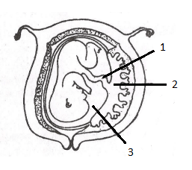Embibe Experts Solutions for Exercise 1: ICSE-2018
Embibe Experts Science Solutions for Exercise - Embibe Experts Solutions for Exercise 1: ICSE-2018
Attempt the free practice questions from Exercise 1: ICSE-2018 with hints and solutions to strengthen your understanding. EMBIBE CHAPTER WISE PREVIOUS YEAR PAPERS FOR SCIENCE solutions are prepared by Experienced Embibe Experts.
Questions from Embibe Experts Solutions for Exercise 1: ICSE-2018 with Hints & Solutions
Mention the exact location of the following:
(i) Epididymis
Give appropriate biological/ technical terms for the following:
The accessory gland in human males whose secretion neutralises the acid in the vagina.
Give appropriate biological/ technical terms for the following:
A surgical method of fertility control in human males.
Given below are diagrams showing the different stages in the process of fertilisation of an egg in the female reproductive tract:
Study the diagrams and answer the questions:

(i) Arrange the letters given below each diagram in a logical sequence to show the correct order in the process of fertilisation.
(ii) Where does fertilisation normally take place? What is ‘implantation’ that follows fertilisation?
(iii) Mention the chromosome number of the egg and zygote in humans.
(iv) Explain the term 'Gestation'. How long does gestation last in humans?
(v) Draw a neat labelled diagram of a mature human sperm.
Name the following:
The structure which connects the placenta and the foetus.
Correct and rewrite the statements by changing the biological term that is underlined in the statement:
The protective sac which develops around the developing embryo is called the Pericardium.
State two functions of testis.
The diagram given below is that of a developing human foetus.
Answer the questions that follow:

(i) Label the parts numbered 1 to 3 in the diagram.
(ii) Mention any two functions of the part labelled 2 in the diagram.
(iii) Explain the significance of part number 3 in the diagram.
(iv) Define the term ‘Gestation’. What is the normal gestational period of the developing embryo?
(v) Mention the sex chromosomes in a male and female embryo.
